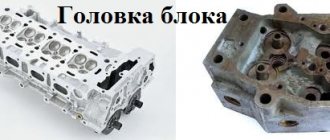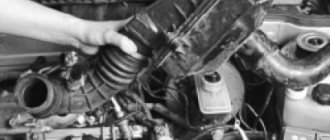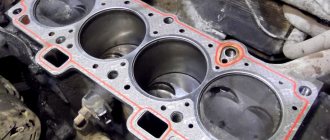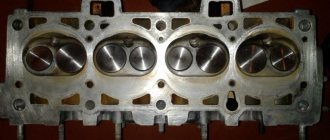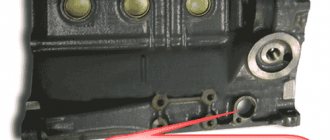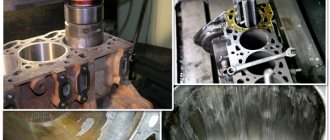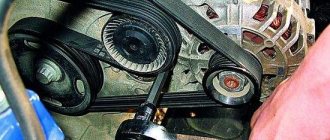Types of cylinder head gaskets
Anyone who removes the cylinder head from an engine especially for the first time then goes to an auto parts store to buy a head gasket, and there are several types of them. And then he wonders which one is better to take.
Types of cylinder head gaskets:
- Asbestos. Withstands high temperatures and is flexible.
- Non-asbestos. The old gasket of this material looks good and does not change its appearance.
- Metal. The most reliable, strong and effectively cope with their tasks.
What's the result?
Taking into account the fact that it is not possible to consider all types of engine gaskets separately within the framework of one article, only the main seals that are used in internal combustion engines were mentioned above.
As a rule, there are entire repair kits (repair kits) of gaskets for different cars on sale. It is important to understand that for each type and model of engine, even from the same manufacturer, the gaskets and seals are different. For this reason, it is necessary to accurately select the necessary parts and elements from the original spare parts catalogs for a specific car model, taking into account the year of manufacture, type of internal combustion engine, etc.
How to independently determine that the cylinder head gasket has burned out. Recommendations for pulling the cylinder head after replacement. Which gasket is better to choose?
Types of sealants for car engines: anaerobic, silicone, belt sealants. Operating principle, differences, scope of application. How to choose the best sealant.
When and why does it become necessary to replace the valve cover gasket. How to replace the valve cover gasket with your own hands. Tips and tricks.
The main reasons for engine oil getting into spark plug wells. What should a driver do if oil flows into the spark plug well, how to carry out repairs with his own hands.
Reasons why coolant starts to leak. How to find the location of an antifreeze or antifreeze leak yourself. Useful tips and tricks.
The principle of operation of sealant for the engine cooling system. When to use sealant, what results to expect. Possible consequences, advice.
Source
When to change the cylinder head gasket
The gasket between the block and the cylinder head has no expiration date. This is not an oil or a part that needs to be changed after a certain period of time. If there are no leaks, the volume of oil does not decrease, the volume of antifreeze, antifreeze or water, depending on what is poured into the cooling system, does not decrease, then it is better not to disturb or disassemble the internal combustion engine simply to replace the gasket.
But, if signs such as:
- visible leaks at the junction of the cylinder head and cylinder head;
- if the color of the oil has changed (some oils become white like milk when mixed with coolant);
- unusual engine stroke with a suspicious color of the exhaust gases (coolant enters the cylinders);
- Oil stains have appeared in the tank with antifreeze, antifreeze or water.
If such signs appear, it is better to stop further use, as this can lead to more expensive repairs than simply changing the cylinder head gasket.
Replacing the cylinder head gasket yourself
In almost all car models, changing the cylinder head gasket is no different. There are small nuances related to the order in which the bolts securing the cylinder head should be tightened and how to adjust the tightening torque of these bolts. All this data can be read in the technical documentation for operating the vehicle. If the documentation is not available in paper form, then it is always possible to find documentation for the desired car model on the Internet.
First, the hanging elements are disconnected. The sequence in which dismantling is carried out must be marked or sketched in the form of a diagram. Once all the bolts are unscrewed, you should disconnect the cylinder head and replace the gasket accordingly. To facilitate centering of the gasket and head, there are special bushings on the block body.
Our target is the cylinder head, which is marked in the image. To replace the cylinder head gasket, you must remove all elements that interfere with operation.
After replacing the gasket, all parts are installed in the reverse order. This is exactly why the diagram was drawn. The cylinder head fastenings must be tightened strictly in accordance with the drawing of the specific mechanism, and strictly maintaining the tension torque characteristics described by the manufacturer. A torque wrench can help with this.
How to change a cylinder head gasket
Car repair work such as replacing the cylinder head gasket with your own hands can and should be learned by those who love various technical devices, who like to spend weekends in warm weather in their garage. To replace, no special abstruse skills are required, you just need to find out the replacement sequence, what tools are needed for this, which gasket to choose correctly before buying and how to install and assemble correctly. By the way, is it necessary to use sealants when replacing gaskets? Learn more about sealants for valve covers and other connecting parts.
How to change the cylinder head gasket:
- Remove all attachments (that interfere with the removal of the head). This is the air filter, etc.
- Unscrew the fastening bolts. There is a rule here - first loosen the bolts in the middle and symmetrically from the middle. At first, each bolt should be loosened only 1 turn. Compliance with this rule will protect the cylinder head plane from microdeformations, since all the bolts are initially thoroughly tightened, if you sharply loosen a couple of bolts from one edge at once, the head may “lead”, then it will come to be taken for grinding.
- Remove the old cylinder head.
- Remove the old cylinder head gasket. If you don’t know how to choose gaskets, it’s better not to immediately throw out the old gasket. You can take it to the auto shop. Because there are different gaskets for the same makes and models of cars. It is necessary to check that the holes in the cooling channels correspond to the holes on the gasket. Because I personally saw it when I tried on a gasket once, and I saw that some holes were not cut out on the gasket, which should be in accordance with the channels of the block.
- Clean the seating surface on the cylinder block thoroughly. If there are hard resins, clean with a knife.
- Install a new gasket on the cylinder block.
- Clean the head seat and install it on the block. Do this carefully, without damaging the gasket.
- Tighten the bolts according to a specific pattern. Tighten the bolts strictly according to the specified scheme developed by the engine manufacturer of a particular machine. The tightening torque is very important for connecting such parts.
- After installation and tightening in a certain order, and with the required optimal tightening torque, we mount the removed attachments.
Do I have to change the bolts when replacing the gasket?
This topic (how to tighten the cylinder head) was discussed in the material: how to remove the cylinder head on the engine of various cars. In short, it is very easy to find out whether it is necessary to change the bolts for securing the cylinder head; just measure the length of the “former” bolts with a ruler.
Find out the length of new bolts for a specific internal combustion engine and compare. If the length has become longer, that is, the bolt has stretched out more than 2 mm, then the bolt must be changed. If the condition of the thread and the length of the bolt and the edges for the key are normal, then it is not necessary to change it. In general, the head gasket requires careful inspection before replacement because the new head gasket may already be damaged.
0
Author of the publication
offline 1 week
Motorist
15
Comments: 25Publications: 324Registration: 04-03-2016
Instructions for replacing the cylinder head gasket
This instruction describes as much as possible the parts that can be dismantled to work with the cylinder head gasket, however, it is not necessary to remove certain parts in all models if they do not interfere with the work. Therefore, you can skip some steps.
Along with the cylinder head cover, related equipment, hoses, and sensors are removed
The cylinder head bolts must be unscrewed gradually from the edges to the center
Old cylinder head gasket in poor condition
The surface of the cylinder head is cleaned
Installing a new cylinder head gasket
After replacing the gasket, it is necessary to return all parts to their original place
You can also watch several videos about replacing the cylinder head gasket:
Replacing the gasket on a VAZ:
Replacing the gasket on a Volkswagen Passat B3:
Replacing the gasket on a Honda Civic:
If you don’t have confidence in your own abilities, and you’re afraid of making things worse, then the best solution would be to take the car to a service center. After all, despite the fact that the operation of changing the gasket is not difficult, its installation is of poor quality. Incorrect assembly of the cylinder head with insufficient force can lead to the appearance of oil or coolant on the surface of the gasket. If this happens, there will certainly be a leak of the liquid poured into the engine block. Which will lead to the need to re-disassemble the cylinder head, replace the gasket again and perform the reverse steps.
In the service center, all work will be performed by qualified specialists, this guarantees quality and speed. Usually in service centers such work is not overpriced.
Criteria for choosing cylinder head gaskets
Basic requirements for cylinder head gaskets. Bolts or studs are used to secure the head to the block. But no matter how precisely the adjacent surfaces of these two parts of the motor are lapped, you cannot do without a gasket. The key parameters of the sealing element are:
Types of cylinder head gaskets.
There are several types of cylinder head gaskets available on the market today.
Cylinder head gasket thickness.
Opening the catalog of any manufacturer, you can find that several gaskets with different thicknesses are offered for the same engine. The final choice depends on how much metal was removed during grinding of the head and/or cylinder block. Therefore, before ordering spare parts, you must consult with a grinder or engine repairman.
We have selected the 10 best cylinder head gasket manufacturers for review. All of them are sold in the trading network of our country. When allocating seats, the magazine's editors took into account the opinion of the expert community and feedback from motorists.
Buy gasket material for the engine: how to choose the right one?
brings to your attention original high-quality gasket materials that you can buy online around the clock.
Here you will find the best prices and high quality products. The company works with well-known manufacturers in the country, with whom it has managed to establish friendly relations over a long period of successful activity.
The range of gasket materials includes the following items:
- cylinder head gasket;
- valve cover packing;
- manifold packing;
- exhaust pipe packing;
- oil sump packing;
- gaskets for the engine housing.
You can order the necessary product right now in just 5 minutes, without leaving the couch. To complete your purchase, add the item to your cart. During the working day, the manager will contact you to clarify the details of the order.
If you have any difficulties when choosing the right spare part, the store consultants will be happy to answer all your general and technical questions. You can also check product availability with them.
